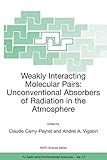Weakly interacting molecular Pairs : unconventional absorbers of radiation in the atmosphere [Libro electrónico] / editors: Claude Camy-Peyret and Andrei A. Vigasin
Camy-Peyret, Claude [editor] | Vigasin, Andrei A [editor].
Tipo de material: Libro
en línea Series Editor: Dordrecht: Springer, c2003Descripción: xix, 287 páginas : il, ; centímetros.ISBN: 1402015968; 9781402015960; 9789401000253 (Online).Nota de acceso: Disponible para usuarios de ECOSUR con su clave de acceso Nota de bibliografía: Incluye bibliografía e índice: páginas 285-287 Número de sistema: 56939Resumen:
Libro
en línea Series Editor: Dordrecht: Springer, c2003Descripción: xix, 287 páginas : il, ; centímetros.ISBN: 1402015968; 9781402015960; 9789401000253 (Online).Nota de acceso: Disponible para usuarios de ECOSUR con su clave de acceso Nota de bibliografía: Incluye bibliografía e índice: páginas 285-287 Número de sistema: 56939Resumen:| Tipo de ítem | Biblioteca actual | Colección | Signatura | Estado | Fecha de vencimiento | Código de barras |
|---|---|---|---|---|---|---|
| Libros | Biblioteca Electrónica Recursos en línea (RE) | Acervo General | Recurso digital | ECO400569398156 |
Incluye bibliografía e índice: páginas 285-287
Disponible para usuarios de ECOSUR con su clave de acceso
The Advanced Research Workshop entitled "Weakly Interacting Molecular Pairs: Unconventional Absorbers of Radiation in the At- sphere" was held in Abbaye de Fontevraud, France, from April 29 to May 3, 2002. The meeting involved 40 researchers from 14 countries. The goal of this meeting was to address a problem that the scienti?c community is aware of for many years. Up now, however, the so- tion for this problem is far from satisfactory. Pair e?ects are called unconventional in the title of this meeting. In speci?c spectral domains and/or geophysical conditions they are recognized to play a dominant role in the absorption/emission properties of the atmosphere. Water vapor continuum absorption is among the most prominent examples. Permanently improving accuracy of both laboratory studies and ?eld observations requires better knowledge of the spectroscopic features - tributable to molecular pairs which may form at equilibrium. The Workshop was targeted both to clarify the pending questions and, as far as feasible, to trace the path to possible answers since the underlying phenomena are yet incompletely understood and since a reliable theory is often not available. On the other hand, the lack of precise laboratory data on bimolecular absorption is often precluding the construction of reliable theoretical models. Ideally, the knowledge accumulated in the course of laboratory studies should correlate with the practical demands from those who are carrying out atmospheric ?eld measurements and space observations. eng
Disponible en línea
Disponible en formato PDF
Subscripción a ELSEVIER 26 de diciembre del 2013
